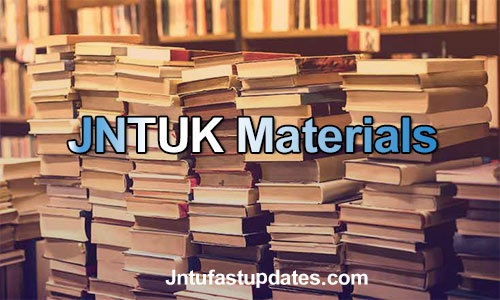JNTUK R20 3-1 AWP Material/Notes PDF Download
Students those who are studying JNTUK R20 ECE Branch, Can Download Unit wise R20 3-1 Antenna and Wave Propagation (AWP) Material/Notes PDFs below.

JNTUK R20 3-1 AWP Material/Notes PDF Download
UNIT-1
ANTENNA FUNDAMENTALS: Introduction, Radiation Mechanism – single wire, 2 wire, dipoles, Current Distribution on a thin wire antenna. Antenna Parameters – Radiation Patterns, Patterns in Principal Planes, Main Lobe and Side Lobes, Beamwidths, Polarization, Beam Area, Radiation Intensity, Beam Efficiency, Directivity, Gain and Resolution, Antenna Apertures, Aperture Efficiency, Effective Height, illustrated Problems.
UNIT-2
THIN LINEAR WIRE ANTENNAS: Retarded Potentials, Radiation from Small Electric Dipole, Quarter wave Monopole and Half wave Dipole – Current Distributions, Evaluation of Field Components, Power Radiated, Radiation Resistance, Beamwidths, Directivity, Effective Area and Effective Height. Natural current distributions, fields and patterns of Thin Linear Center-fed Antennas of different lengths, Radiation Resistance at a point which is not current maximum. Antenna Theorems – Applicability and Proofs for equivalence of directional characteristics, Loop Antennas: Small Loops – Field Components, Comparison of far fields of small loop and short dipole, Concept of short magnetic dipole, D and Rr relations for small loops.
UNIT-3
ANTENNA ARRAYS : 2 element arrays – different cases, Principle of Pattern Multiplication, N element Uniform Linear Arrays – Broadside, End-fire Arrays, EFA with Increased Directivity, Derivation of their characteristics and comparison; Concept of Scanning Arrays. Directivity Relations (no derivations). Related Problems. Binomial Arrays, Effects of Uniform and Non-uniform Amplitude Distributions, Design Relations. Arrays with Parasitic Elements, Yagi-Uda Arrays, Folded Dipoles and their characteristics.
UNIT-4
NON-RESONANT RADIATORS : Introduction, Traveling wave radiators – basic concepts, Long wire antennas – field strength calculations and patterns, Microstrip Antennas-Introduction, Features, Advantages and Limitations, Rectangular Patch Antennas –Geometry and Parameters, Impact of different parameters on characteristics. Broadband Antennas: Helical Antennas – Significance, Geometry, basic properties; Design considerations for monofilar helical antennas in Axial Mode and Normal Modes (Qualitative Treatment).
UNIT-5
VHF, UHF AND MICROWAVE ANTENNAS: Reflector Antennas : Flat Sheet and Corner Reflectors. Paraboloidal Reflectors – Geometry, characteristics, types of feeds, F/D Ratio, Spill Over, Back Lobes, Aperture Blocking, Off-set Feeds, Cassegrain Feeds. Horn Antennas – Types, Optimum Horns, Design Characteristics of Pyramidal Horns; Lens Antennas – Geometry, Features, Dielectric Lenses and Zoning, Applications, Antenna Measurements – Patterns Required, Set Up, Distance Criterion, Directivity and Gain Measurements (Comparison, Absolute and 3-Antenna Methods).
WAVE PROPAGATION: Concepts of Propagation – frequency ranges and types of propagations. Sky Wave Propagation – Formation of Ionospheric Layers and their Characteristics, Mechanism of Reflection and Refraction, Critical Frequency, MUF and Skip Distance – Space Wave Propagation – Mechanism, LOS and Radio Horizon.– Radius of Curvature of path, M-curves and Duct Propagation.
Download UNIT-5 PART-B Material PDF
TEXT BOOKS:
- Antennas for All Applications – John D. Kraus and Ronald J. Marhefka, 3rd Edition, TMH, 2003.
- Electromagnetic Waves and Radiating Systems – E.C. Jordan and K.G. Balmain, PHI, 2nd Edition, 2000.
REFERENCE BOOKS:
- Antenna Theory – C.A. Balanis, John Wiley and Sons, 2nd Edition, 2001.
- Antennas and Wave Propagation – K.D. Prasad, Satya Prakashan, Tech India Publications, New Delhi, 2001.
OUTCOMES:
- Identify basic antenna parameters.
- Design and analyze wire antennas, loop antennas, reflector antennas, lens antennas, horn antennas and micro-strip antennas
- Quantify the fields radiated by various types of antennas
- Design and analyze antenna arrays
- Analyze antenna measurements to assess antenna’s performance
- Identify the characteristics of radio wave propagation

320-x100(1).gif)



